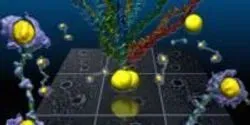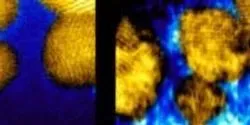nanostructures

A combination of nano-sized pores and the use of a special coating called preen oil makes Antarctic penguin feathers ultra-water-repelling, which keeps them ice-free

Scientists around the world are using the programmability of DNA to assemble complex nanometer-scale structures. Until now, however, production of these artificial structures has been limited to water-based environments, because DNA naturally functions inside the watery environment of living cells.

Collective, fast diffusion observed by Ames Laboratory team could represent a new way to grow perfect, tiny metal nanostructures.

Delivering the capability to image nanostructures and chemical reactions down to nanometer resolution requires a new class of x-ray microscope that can perform precision microscopy experiments using ultra-bright x-rays from the National Synchrotron Light Source II (NSLS-II) at Brookhaven National Laboratory. This groundbreaking instrument, designed to deliver a suite of unprecedented x-ray imaging capabilities for the Hard X-ray Nanoprobe (HXN) beamline, brings researchers one step closer to the ultimate goal of nanometer resolution at NSLS-II, a U.S. Department of Energy Office of Science User Facility.















